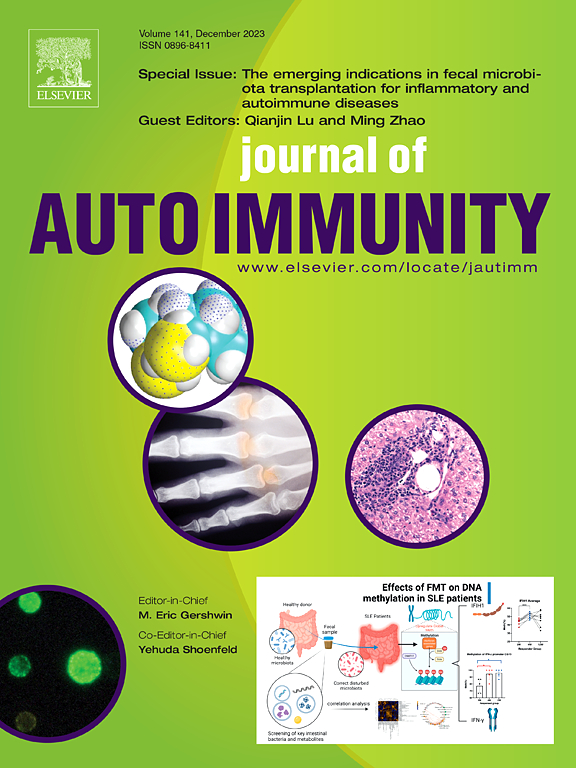表达 ST2 的滑膜调节性 T 细胞通过抑制免疫调节性嗜酸性粒细胞使关节炎症恶化
IF 7.9
1区 医学
Q1 IMMUNOLOGY
引用次数: 0
摘要
类风湿性关节炎(RA)是一种以慢性多关节炎为特征的自身免疫性疾病。辅助性 T 细胞在类风湿性关节炎的发展和恶化过程中发挥着至关重要的作用,这一点已得到公认。最近的研究还揭示了调节性 T(Treg)细胞在其中的重要作用。虽然分布在外周组织的 Treg 细胞表现出多种功能,但滑膜 Treg 细胞的特征仍然未知。在这项研究中,我们证明滑膜 Treg 细胞通过竞争性消耗 IL-33 减少免疫调节嗜酸性粒细胞的数量,从而加剧滑膜炎症。滑膜 Treg 细胞在小鼠关节炎模型中表达 ST2,令人惊讶的是,Treg 特异性 ST2 基因敲除(ST2ΔTreg)小鼠的关节炎症状有所减轻。在 ST2ΔTreg 小鼠中,观察到免疫调节性滑膜嗜酸性粒细胞增加。此外,还发现免疫调节嗜酸性粒细胞表达 ST2,而表达 ST2 的 Treg 细胞可能通过消耗 IL-33 来控制免疫调节嗜酸性粒细胞的数量。我们的研究结果突出表明,滑膜 Treg 细胞亚群拥有通过抑制嗜酸性粒细胞来恶化关节炎的机制。在采用基于 Treg 细胞的疗法治疗自身免疫性疾病的未来前景中,了解与疾病相关的 Treg 细胞的特征非常重要。了解这些方面对于确保更安全的治疗模式不会无意中恶化疾病至关重要。本文章由计算机程序翻译,如有差异,请以英文原文为准。
Synovial regulatory T cells expressing ST2 deteriorate joint inflammation through the suppression of immunoregulatory eosinophils
Rheumatoid arthritis (RA) is an autoimmune disease characterized by chronic polyarthritis. It is well-established that helper T cells play crucial roles in the development and deterioration of RA. Recent studies also revealed the significant roles of regulatory T (Treg) cells in this context. Although Treg cells distributed in peripheral tissues exhibit various functions, the characteristics of synovial Treg cells remain unknown. In this study, we demonstrate that synovial Treg cells exacerbate synovial inflammation by reducing the number of immunoregulatory eosinophils through competitive consumption of IL-33. Synovial Treg cells expressed ST2 in a murine arthritis model, and surprisingly, Treg-specific ST2 knockout (ST2ΔTreg) mice exhibited attenuated arthritis. In ST2ΔTreg mice, an increase in immunoregulatory synovial eosinophils was observed. Additionally, immunoregulatory eosinophils were found to express ST2, and ST2-expressing Treg cells controlled the abundance of immunoregulatory eosinophils, possibly by consuming IL-33. Our results highlight that a subset of synovial Treg cells possesses the machinery to worsen arthritis by suppressing eosinophils. In the future landscape where Treg cell-based therapies are employed for autoimmune diseases, it is important to comprehend the characteristics of disease-related Treg cells. Understanding these aspects is crucial for ensuring safer treatment modalities that do not inadvertently worsen the diseases.
求助全文
通过发布文献求助,成功后即可免费获取论文全文。
去求助
来源期刊

Journal of autoimmunity
医学-免疫学
CiteScore
27.90
自引率
1.60%
发文量
117
审稿时长
17 days
期刊介绍:
The Journal of Autoimmunity serves as the primary publication for research on various facets of autoimmunity. These include topics such as the mechanism of self-recognition, regulation of autoimmune responses, experimental autoimmune diseases, diagnostic tests for autoantibodies, as well as the epidemiology, pathophysiology, and treatment of autoimmune diseases. While the journal covers a wide range of subjects, it emphasizes papers exploring the genetic, molecular biology, and cellular aspects of the field.
The Journal of Translational Autoimmunity, on the other hand, is a subsidiary journal of the Journal of Autoimmunity. It focuses specifically on translating scientific discoveries in autoimmunity into clinical applications and practical solutions. By highlighting research that bridges the gap between basic science and clinical practice, the Journal of Translational Autoimmunity aims to advance the understanding and treatment of autoimmune diseases.
 求助内容:
求助内容: 应助结果提醒方式:
应助结果提醒方式:


